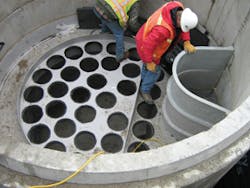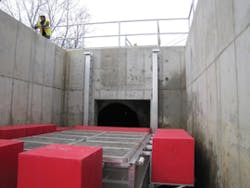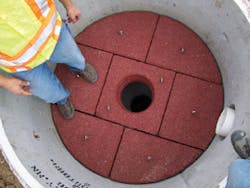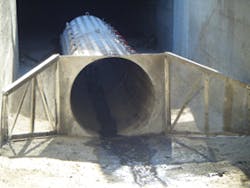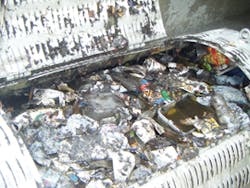National Pollutant Discharge Elimination System (NPDES) Phase II requires control of runoff from sites both during construction and after construction. Post-construction runoff control usually involves more permanent (and more expensive) devices than the temporary berms, silt fence, and other materials used during active construction.
These permanent devices fall into two general categories: underground filtration systems (sometimes called hydrodynamic separators) and catch basin inserts. Each system has its own strengths and weaknesses.
Hydrodynamic separators are typically used in urban areas for removal of suspended sediments and floatables (trash, debris, and oil, for example) from stormwater, particularly when space limitations prevent the use of other best management practices (BMPs).
“Hydrodynamic separators are most effective where the materials to be removed from runoff are heavy particulates—which can be settled—or floatables, which can be captured, rather than solids with poor settleability or dissolved pollutants,” according to EPA.
Catch basin inserts can drop directly into existing catch basins, or can be retrofit if necessary. They are designed to remove a variety of items from stormwater runoff including trash, debris, oil, and sediment. These inserts tend to be relatively inexpensive and work well for gross solids removal. However, they may not be as effective for removal of soluble pollutants or fine particles, and they can lose effectiveness if not cleaned as needed.
Catch Basin Inserts Help Keep Pacifica Clean
In October 2009, the San Francisco Estuary Partnership was awarded $5 million in federal stimulus funds to support the Bay Area-wide Trash Capture Demonstration Project. Participating communities receive trash capture devices to retrofit their existing storm drainage infrastructure.
Pacifica, CA, population 37,000, located along the coast just south of San Francisco, chose to be a part of this program. Raymond Biagini, field services manager for the Pacifica Public Works Department, explains how the city selected which device to use.
“With this program, there are only a few vendors we can use, and there are only certain devices that they allow, that are considered full capture devices,” he says. “Much of our stormwater empties into San Pedro Creek, and that feeds our bay, so I had to be cautious regarding where to locate catch basins.”
Over the years, Biagini had seen a variety of systems in place and chose to take a closer look at the FloGard+Plus catch basin filter inserts manufactured by KriStar Enterprises.
“It seemed to be a nice system,” he says, “and they came down, showed me a sample, and actually had one built for me free of charge and installed it. I could therefore see how it would be to maintain it and take it out. Through trial and error, I was happy with this device.” In the summer of 2011, Biagini ordered 40 of these catch basin inserts for the initial phase of the project.
“The mesh on these 40 units is a stainless steel structure, which is what we use because we’re close here to the ocean,” he explains. “I was worried about the salt air if I went to a regular galvanized or regular steel structure that might not last as long. It was a little more expensive to go with the stainless steel, but in the long run it will be more cost effective.
“This whole device is the framing and the mesh part of it. The mesh is so much smaller than the top grate that you’re able to capture cigarette butts and similar items. Basically, it’s just a smaller type of meshwork that fits into the existing catch basin, and then the grate fits right on top of it. So I have a two-ply system.”
Biagini reports that he has approximately 1,100 catch basins in Pacifica in total. “We do have grates on these catch basins, but not a full-capture device like the KriStar devices we’re using now. We just had a storm of a couple inches of rain within a 24-hour period, and [the FloGards] work well. They work so well that we had to go out and clean them many more times than normal. They catch cigarette butts and leaves and plastics–whatever is in the gutter that finds its way into a drop inlet or catch basin.”
The frequency with which the inserts need to be cleaned varies. “It depends on the area and the time of the year,” says Biagini. “In the fall, if there are a lot of leaves in the area, I know I may have to go out more frequently in those spots. In some residential areas, we have a lot more trees where these basins are, but in some of the business areas there aren’t many trees, so those areas with fewer trees I would visit less.”
He added that the installation process was relatively pain-free. “KriStar has been very helpful. They came out and took individual measurements of each basin, because they’re all different sizes. It was actually a pretty smooth transition.
“I’m happy with the devices. I actually have a phase 2 element, and there is money available through this program, and we’re hoping to add another 40. There are quotas and obligations that we have to meet by 2014, where we have to be more efficient with the type of debris and the amount of debris that need to be collected. We should be around 80 to 90% of full capture by that time.”
Turbidity at Tahoe
Magnificent Lake Tahoe straddles the California-Nevada border, and residents take their water quality very seriously. “Their goal is to keep the lake as blue as possible. Turbidity is a big issue for them,” explains Daniel Wilson, director of government and public affairs for Imbrium Systems.
The filter’s small footprint was important for the location.
“It’s a huge focus,” adds Mark Gookin, principal engineer with the Wood Rodgers engineering firm. “There’s a lot of source control work, including revegetation on slopes. Some slopes require rock or retaining walls, because they’re so steep that they can’t successfully be revegetated.
“They have been working on a TMDL [total maximum daily load] for long time, and in the last year or so, they’ve promulgated some pretty rigorous requirements to try to capture the really small particles. Certainly, even with current projects, it’s not going to happen all the time. There are some times that you just physically can’t put something in that will remove the fine sediment. But that is the target.
“They’ve determined that the primary cause of the loss of clarity in the lake is the really fine sediment, the sediment that’s less than 16 microns in size. The fine sediment loading is mainly from the heavily used roadways and developed areas of the Lake Tahoe Basin.”
One of the areas that was selected for treatment is an area along State Route 28 in Incline Village, on the Nevada side of the North Shore portion of the lake.
“In that area, we had topographic constraints with steep slopes, both on the downhill side of State Route 28 and on the uphill side of the road,” says Gookin. “So we had limited room from a topographic standpoint, and we also had some nearby utilities. There is a sewer force main that is nearby that we needed to avoid. Any impact on that force main is a bad deal, because if you shoot sewage into Lake Tahoe, they don’t like that.”
To capture the fine sediment, the new Jellyfish Filter from Imbrium Systems was installed. “We believe the Jellyfish Filter, with its patented high-flow membrane technology, adds an exciting new dimension to stormwater filtration,” says Wilson. “No other stormwater filter device has a smaller footprint, higher flow rate per cartridge, or can capture sediment down to 2 microns.”
“The smaller footprint was crucial,” notes Gookin. “For the flow rates we’re trying to treat, the Jellyfish had the smaller footprint, which was critical for that location.”
“Throughout the planning process for these Nevada Department of Transportation [NDOT] efforts, we’ve worked closely with NDOT maintenance,” he adds. “They’re hoping that the Jellyfish unit will be easier to maintain.
The Nutrient Separating Baffle Box
When cartridge replacement is required, the cartridges that you pull out are less than 50 pounds, even when wet. So it’s anticipated to be easier to maintain than perhaps some other units.
“They have to regularly vacuum-hose the Jellyfish part of it through the access in the cartridge deck to remove material. Through regular maintenance, the frequency of replacement of the cartridges can be reduced.
“We think we’ve stopped, or at least reduced, the loss of clarity. It was regularly decreasing for the last 30 years. But we think we’ve got to the point where it’s stabilized. The trend seems to at least have flattened, and it’s starting to improve again. The belief is that by strict application of standards to reduce fine particles getting into the lake, they can get it back to around 100-foot clarity, which it used to be.”
Gookin notes that a number of pollutants are being closely watched. “They are concerned about hydrocarbons, and they’re concerned about nutrients like phosphorus and nitrogen. Those are all issues of concern, but the primary one is the really fine sediment.
“In areas in which there is enough room, we use things like infiltration basins that allow the water to infiltrate. But the topography is just so tight in most of the areas that we don’t have room to do a traditional infiltration basin. We have to go to the treatment vaults, like the Jellyfish, more often because it’s a really constrained area.”
Gookin was surprised by the ease of installation of the system. “They were incredibly quick getting that in there,” he says. “It was even snowing a little bit, I think, when they did it. They did some of the excavation the afternoon before, and they got that unit dropped in there in less than half a day.”
Wilson notes that independent verification of the Jellyfish system has come from several state agencies, including the New Jersey Center for Advanced Technology. According to Wilson, that means that the field test that Imbrium Systems submitted has been reviewed by three state-appointed experts, and they find it to be credible and accurate.
Baffled in Washington
Washington, IN, population 11,500, lies in the southwestern portion of the state, about 60 miles north of Evansville. “We have a combined sewer system, and we’re an old community,” says Scott Rainey, superintendent of the city’s Storm Water Department. “We also have littering issues, as most communities do. So we have all the pop bottles and generic trash and debris that gets washed in. But we don’t have anything other than mechanical bar screens to keep stuff out of our sewer system.”
Installation of the ecoStorm Plus unit
Rainey spent time exploring alternatives that would minimize debris entering Hawkins Creek, where the untreated water ultimately flows. After considering a variety of underground separators and consulting with a number of other communities, Rainey came up with a unique solution to his town’s water treatment needs.
“For our application,” he says, “we have a four-million-gallon settling tank to meet our one-year, one-hour storm event requirements. When that tank fills up with stormwater, then the overflow goes to a 21-acre wetland we had constructed.”
At the head of that wetland sits a Nutrient Separating Baffle Box, manufactured by Suntree Technologies and supplied by Jen-Hill Construction Materials. The contractor for the project was Bowen Engineering.
Trey Hightower of Jen-Hill explains the system. “The Nutrient Separating Baffle Box screen system for this project was set on floats and tracks that are bolted to the inside of the concrete structures, so it can rise and fall with the water level. There is also a SkimBoss floating skimmer on the downstream side of the structure that also rises and falls with the water level to prevent floatables from overtopping the SkimBoss.”
Lenin Kasthuri, project engineer with Bernardin, Lochmueller and Associates Inc., adds, “The system is designed to filter out biological oxygen demand [BOD], total suspended solids, and ammonia, in addition to floatables and grit.”
Rainey was pleased with what he saw. “This unit caught my eye initially because of the fact that it has very few moving parts. What does move is not wheels, just nylon bushings. They’re innovative with their floating remova
The Storm Flo Screen captures trash and debris.
l system. It also has not one but three separate chambers, so it has a second and third degree of sediment removal, which is something we felt we needed with the kind of volume we’ll be moving. The more we can take out before it gets into the wetland, the less cleaning we have to do in the wetland. That was a big plus for us.
“We set this up mainly to polish off the nutrient issues that may still be in the rainwater. When that first flush comes in during a rain event, we’ll catch and treat that first flush. Anything over and above that, we’ll send to the wetland. What we designed the wetland for primarily is to handle the nutrient load, that light BOD loading that comes in there. Then there is an ultraviolet light disinfection system before it gets released back into Hawkins Creek.”
Rainey says that maintenance of the system is fairly simple. “Periodically, you’ll need to open up two sets of doors,” he explains. “With the first set of doors, you can take out floatables, and if you need to clean out your sediment box, you just open up the next set of doors. It’s a pretty user-friendly application.”
The system was installed in November 2011 and went fully online about four months later. “We looked at a lot of different options, but it looked like this one was the best to get rid of sediment. It was critical for us to get rid of that sediment,” says Rainey.
Filtering and Monitoring Runoff in Redmond
Luke McRedmond Landing is a beautiful 2 1/2-acre park in Redmond, WA, featuring a picnic area, canoe launch, a fishing pier for the physically challenged, and lots of open space.
According to Lance Hoff, water resources engineer with Royal Environmental Systems, the park also contains a tributary area that drains to the Sammamish River, which drains to Lake Washington and subsequently to Puget Sound.
“In anticipation of larger future facilities needed for protection of Lake Sammamish and the Sammamish River,” says Hoff, “a pilot project was installed, consisting of an ecoStorm hydrodynamic separator unit located upstream of an array of four five-foot-diameter ecoStorm Plus filtration units.
“A small footprint for the treatment system at McRedmond Park was a necessity because of site constraints. The most desirable location for the system was below a small parking lot associated with the park, and the small footprint of the ecoStorm Plus treatment train in comparison to its high treatment capacity was desirable. Also, due to the close proximity to the river, a high groundwater table was a design constraint during and after construction. During construction, dewatering was necessary for installation of the system. For ease of backfilling, the system was backfilled using flowable fill–low-strength concrete.”
Hoff adds that there were additional site design constraints that limited the options for the city. “Little grade was available in the existing storm sewer system to install a traditional cartridge stormwater filtration system, which requires relatively large operating heads. The ecoStorm Plus’s porous concrete filter and upflow design provide high removal efficiencies with low operating heads–only a few inches of head loss at the design treatment flow rate of 180 gpm.”
The area’s primary pollutants of concern are sediment, heavy metals, and nutrients. “To date, monitoring has primarily been focused on sediment removal,” says Hoff. “The influent sediment gradation was fairly typical of urban runoff with a median particle size of 60 microns. However, the influent sediment concentrations were very low, with median values of 48 milligrams per liter for composite and 76 milligrams per liter for discrete samples. Low influent concentrations can be problematic when determining removal efficiencies of filters, as it is typically more difficult to achieve high removal efficiencies with low influent concentrations. Despite the low influent concentrations, the ecoStorm/ecoStorm Plus treatment system was shown to have median effluent concentrations of nine milligrams per liter for composite and 17 milligrams per liter for discrete samples, or approximately 80% removal. Results from the McRedmond system monitoring are currently under review at the DOE [Washington Department of Ecology] for approval of the ecoStorm/ecoStorm Plus treatment train as a general use level designation total suspended solids removal device. The ecoStorm Plus’s porous concrete filter also contains additives that provide for the remove of dissolved pollutants.”
Maintenance of the system is handled by the city of Redmond. “Filters are backflushed on average once every two months, and replaced annually,” explains Hoff. “Backflushing involves vacuuming down the water level to below the–typically submerged–filter, and running water over the top of the filter to force particulates out of the filter and into the sump. Spent filters are removed and replaced in seven pieces through the structure’s 30-inch-diameter access.”
There weren’t many surprises with installation of the system, but Hoff noted one unexpected issue. “A large construction project adjacent to the site at the onset of monitoring affected the performance of the system and monitoring results. The monitoring itself is complicated and required fine-tuning–positioning of the sampler intakes, setup and calibration of the monitoring system to gather viable samples within the constraints of the qualifying event definitions, collecting composite and discrete samples for comprehensive results, proper storage and analysis of samples, waiting for qualifying precipitation events for adequate statistical confidence, and so on. The large amount of organic matter, primarily consisting of cherry blossoms in the spring and leaves in the fall, generated in a 90% impervious drainage area was not anticipated. The ecoStorm was retrofitted with a screen to address this issue.”
Keeping Southern California Clean
A popular southern California attraction built an addition to its maintenance and tram parking area, and that triggered a stormwater requirement for the water leaving the property.
“Because it’s one of the lowest areas in the facility, it empties right into a creek and exits the property, then goes across the road and into fields,” explains Joe Arthur of Clearwater Solutions, manufacturer of the ClearWater BMP catch basin filter. “Farther south, it reaches some agricultural areas and ends up in a nearby river eventually. They were required by mandate to put filters in. We went down and installed three of them.”
The installation went well, but a problem soon arose. “There was a dirt road right above the pavement of the entry into the tram parking area,” says Arthur, “and every time it rained, one of the filters would become perhaps a third full. This happened with every rain. So of the three filters in the facility, one had a really heavy load, and the other two were a bit lower. There are curbs and gutters and other permanent BMPs in place, with planted areas here and there, so there’s not quite the same contribution into the other two filters. Those only need to be maintained once per year. They all have the same size filter in them, but it just so happens that where they’re located, the one is pretty heavy, one is medium and one is lighter.
“What they have done since is pave the road that runs around the full perimeter of the facility. Now that it is paved, it’s not nearly the problem that it once was.”
Arthur handles the maintenance of the three units himself. “I only need to go out there once a year, unless we get a whole lot of rain,” he says. “If you don’t have your control BMPs, which are your curbs and gutters and grass growing, then that contributes to the maintenance cycle and the material that the units are exposed to. Replacement of the filters is just a matter of 15 to 20 minutes. Getting the debris out of it might be half an hour to 45 minutes. It depends on how much is in there and how solid it has become.
“The filter cartridge has media in it. Our filter is designed so that it actually has three points where the water is flowing and is allowed to settle. One of them is the primary chamber, one is the secondary chamber, then it flows over the final weir and through a coarse filter, and then through this media filter.
“What that allows it to do is to clean the water more efficiently, because it’s not exposing the media filter to the full debris and sediment load. About 80 to 85% of all the sediment and turbidity is being removed in the first chamber. It’s the largest and has the longest contact flow time. On the first weir wall, we reduce the size of debris that can move forward. Then the material goes over a weir wall and it settles again, and then it goes through the media.
“On an annual cycle,” he estimates, “there’s probably 250 to 300 pounds of sediment debris that the filters have removed.”
The Gizzard of Glendale
The city of Glendale, CA, in Los Angeles County, has a number of catch basin inserts in place, but after examining alternatives, also installed a Storm Flo Screen from Roscoe Moss.
Maurice Oillataguerre, senior environmental program specialist for Glendale, explains a bit about the system. “It’s a circular pipe, and it has louvers in it that capture trash, and the louvers allow it to dewater. Instead of using five-millimeter holes, they basically just use these louvers, and it retains five-millimeter trash. They got their [full-capture] certification from the regional board, so it’s a full-capture-certified unit.
“CalTrans [the California Department of Transportation] has been using it for several years, and they’ve had some pretty good experience with it,” he says. “Mosquito breeding is always an issue when you put in some kind of BMP. You want to make sure that it dewaters within 72 hours.”
CalTrans termed the device a GSRD (pronounced “gizzard), which stands for gross solids removal device. “We really like it, and think it’s a great way of removing trash,” says Oillataguerre.
“We still have catch basin screen inserts, which are just a vertical five-millimeter screen with an overflow. These remove trash, but they’re a lot more labor-intensive. For instance, the Roscoe Moss GSRD we installed serves about 80 catch basins, so instead of going into 80 catch basins and putting in a five-millimeter vertical screen that you have to clean out every couple of months, we have 80 of these going into the Roscoe Moss unit. You have only one cleanout for all of the catch basins, so it’s a much more cost-effective way of removing trash.
“We clean it out about every four months. It’s very easy to clean with a Vactor truck–very easy maintenance. We haven’t had any problems at all. It is hard to believe that all of this trash would have ended up in the Pacific Ocean if we did not install the unit,” he says. “It’s bulletproof, very easy to maintain, and it dewaters without a problem.”
Oillataguerre says that to date, he has not experienced any problem with heavy storms, but adds that the system is not intended to handle extremely heavy rainfall. “It’s not sized to capture really large rain events. In that case, there’s an overflow, and it just goes out into the L.A. River and then into the ocean.
“In order to comply with the TMDL, you have to remove a level of trash for a certain size storm event, and that’s the 85th percentile storm event. Anything beyond that storm event can go untreated. You don’t have to put it through the GSRD.”
